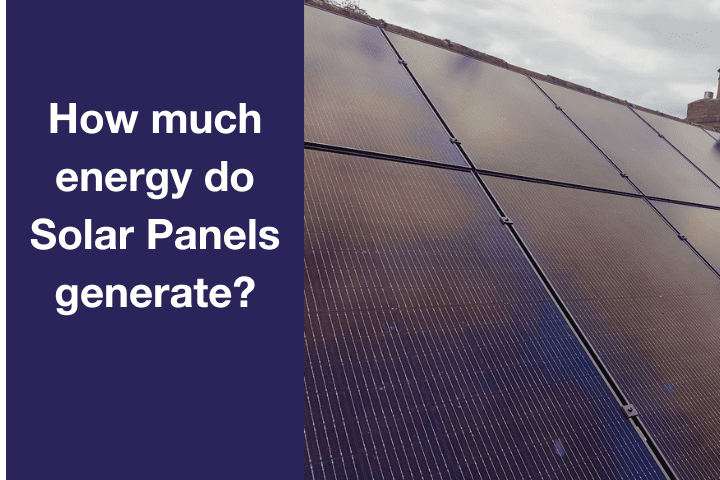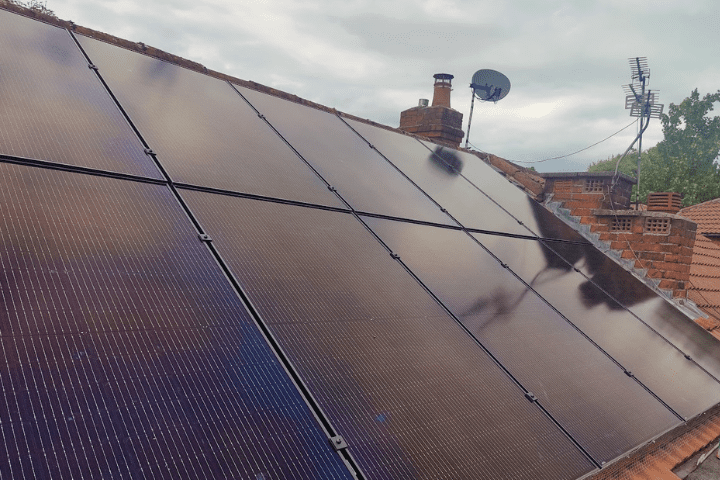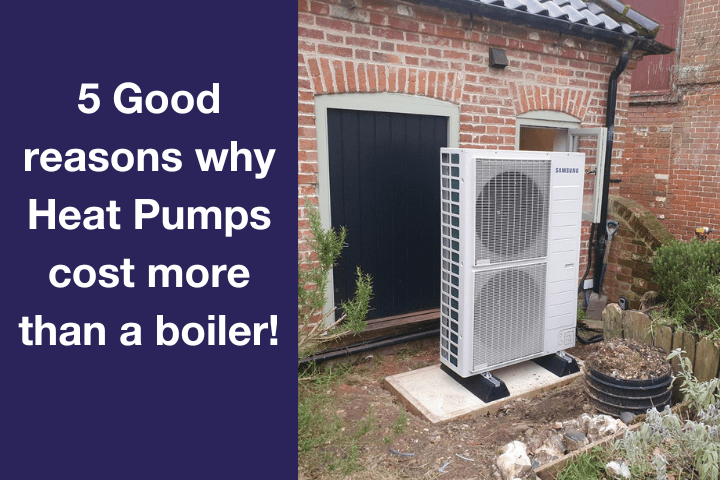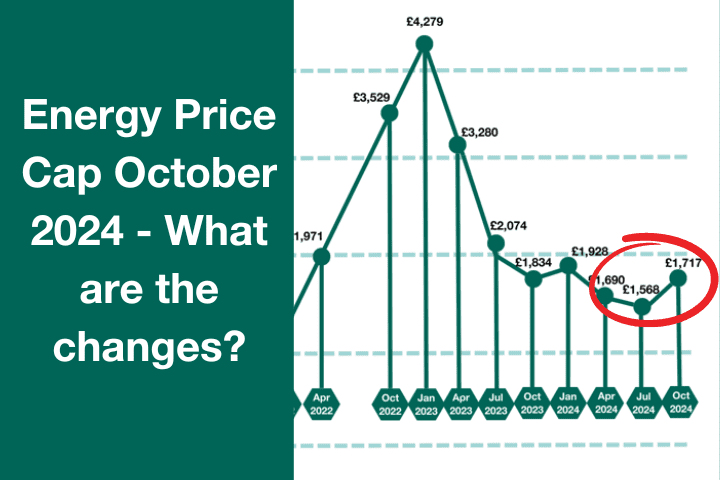Solar Panels: How Much Energy Do They Generate? 5 different scenarios

Are you considering switching to solar energy for your home? One of the most common questions homeowners ask is, “How much energy do solar panels generate?”
In this blog, we’ll break down the energy output of different-sized solar panel systems and highlight the key benefits of using solar panels in the UK.
Table of Contents
Understanding Solar Panel Energy Output
Solar panels convert sunlight into electricity through photovoltaic cells. The amount of energy they generate depends on several factors. Understanding how these factors affect energy generation can help you make informed decisions about your future solar panel installation.
- Panel Efficiency: In the UK, solar panels typically have efficiency ratings ranging from 15% to 22%. Opting for higher efficiency panels is advantageous, as it allows for maximised energy capture even in areas with limited roof space. Investing in top-tier panels can significantly reduce electricity bills over time for homeowners looking to optimise savings. At Green Building Renewables, we only install Tier 1 solar panels, which have around 21-22% efficiencies.
- Geographic Location: Your home’s geographical location in the UK significantly affects solar energy production. For instance, homes in sunnier regions, such as the South East, can generate more energy than in areas with frequent rainfall, like the West Midlands. However, the general increase in average sunlight hours during summer months across the UK makes solar an attractive option even in less sunny regions, especially aided by improved panel technology.
- Angle and Orientation: In the UK, to maximise solar energy output, panels should ideally face south, with a tilt angle that corresponds to your specific latitude. Given the country’s geographic diversity, homeowners may need to adjust their panel installation to ensure optimal sunlight exposure, particularly during varying seasonal conditions. Due to the developments in solar inverter technology, solar arrays can have multiple string setups, which means you can optimise more than one roof elevation. Making it possible for different elevations to capture solar energy at different times of the day.
- Weather Conditions: In the UK, where cloudy weather is not uncommon, homeowners need to consider the performance of their solar systems during these periods. However, with advancements in solar technology, many modern panels are designed to function efficiently even in lower light conditions, extending their viability in different weather scenarios across the country. Remember that solar panels work on solar irradiance and not solar heat energy. It’s the amount of light, not the amount of sun’s heat, so even on those overcast days, they will work as long as there is light.
Benefits of Using Solar Panels
Aside from reducing carbon emissions and promoting renewable energy, there are numerous advantages to using solar panels in your home. One significant benefit is the potential for substantial savings on energy bills. You can reduce your reliance on grid power and decrease your monthly utility costs by generating your electricity. Additionally, any excess energy produced can often be sold back to the grid, providing an extra source of income or be stored in batteries, which you can use when the sun isn’t shining.
Another key benefit is the increase in property value. Adding solar panels or any renewable technology makes your home a better-performing building. Homes equipped with solar panels are often seen as more attractive in the housing market, enhancing their resale value. Potential buyers may appreciate lower energy costs and a reduced carbon footprint. Furthermore, government incentives and schemes, such as the Smart Export Guarantee available in the UK, can further offset installation costs, making solar energy an economically wise decision.
Moreover, solar panels provide energy independence. By generating your power, you are less susceptible to fluctuations in energy prices and supply disruptions. Lastly, adopting solar energy is a powerful step towards sustainability, helping combat climate change by reducing reliance on fossil fuels.
Different-sized solar panel systems and their outputs
To give you a clearer picture, let’s look at the energy output of different-sized solar panel systems. Remember, a solar array can be spread across different parts of your roof and elevations. It can also be incorporated onto things like garage roofs or even be ground-mounted. So, when considering the area needed for each installation, this doesn’t always need to be all on one roof elevation.
The following examples are based on average figures. The actual energy generated by any solar array will depend upon the factors listed above.
8-Panel System
An 8-panel system is a great starting point for smaller homes or those new to solar energy. Assuming an average performing panel where each panel typically generates around 300 watts of power. (At Green Building Renewables, we install panels that are better performing with 430W of power more common).
- Total Output: 2.4 kW (kilowatts)
- Estimated Monthly Generation: Approximately 216 kWh (kilowatt-hours)
- Total Area Required: Approximately 13 square meters
To understand whether an 8-panel system meets your energy needs, it’s helpful to know the average energy consumption of a typical home in the UK. On average, a UK household consumes about 10-12 kWh (kilowatt-hours) per day. This translates to roughly 300-360 kWh per month and around 3,600-4,320 kWh annually.
In comparison, an 8-panel system generating approximately 216 kWh per month might not cover all of the electricity needs of an average home but could significantly offset your energy bills. It’s essential to evaluate your specific energy usage and consider the potential upsides of adding more panels or incorporating energy-saving measures to maximise the efficiency of your solar power system.
10-Panel System
A 10-panel system offers more power, suitable for medium-sized homes with moderate energy needs.
- Total Output: 3 kW
- Estimated Monthly Generation: Approximately 270 kWh
- Total Area Required: Approximately 17 square meters

12-Panel System
A 12-panel system is suitable for medium-sized homes looking to cover a larger portion of their energy requirements. Each panel generates around 300 watts of power. It is one of the most common size systems we install.
- Total Output: 3.6 kW (kilowatts)
- Estimated Monthly Generation: Approximately 324 kWh (kilowatt-hours)
- Total Area Required: Approximately 20 square meters
With this system, you can cover a substantial portion of your monthly energy needs, potentially providing enough electricity for an average UK household for the entire year—translating to about 3,888 kWh annually.
The 12-panel solar system is particularly popular in the UK due to its ability to balance energy generation with the diverse needs of many households. With a total output of approximately 3.6 kW, this system is well-suited for medium-sized homes, typically accommodating families with moderate to high energy consumption. Its estimated monthly generation of around 324 kWh can significantly offset the average family’s electricity usage, which hovers around 300-360 kWh per month.
One critical advantage of a 12-panel setup is its compatibility with various household appliances. This allows homeowners to power everything from refrigeration to heating without reliance on grid energy during peak usage times. Investing in a 12-panel system can create a more predictable energy budget while reducing carbon footprints in the context of fluctuating energy prices and increasing awareness about sustainability.
Moreover, this system’s capacity for production often means homeowners may generate surplus energy during sunny months. With energy storage solutions like Tesla Powerwalls, excess energy can be stored for later use, ensuring a continuous power supply during less sunny days. Additionally, households can benefit from any surplus energy generated, as it can often be sold back to the grid through various feed-in tariff schemes, turning a solar investment into a source of income. As such, a 12-panel solar system represents a practical choice for home energy needs and supports eco-friendly initiatives and economic savings.
You must allocate sufficient roof space to successfully install a 12-panel solar system. On average, each solar panel measures about 1.7 square meters. Therefore, for a 12-panel system, the total space required is approximately 20.4 square meters. It’s important to consider not just the total area but also the orientation and angle of the roof to maximise sunlight exposure. Any shading from nearby trees or buildings should also be assessed to ensure optimal energy generation. Proper installation also requires adequate space for access and maintenance, so planning the layout effectively is crucial for an efficient solar setup.
16-Panel System
A 16-panel system offers an extensive energy output for larger homes or those with higher electricity demands. Each panel generates around 300 watts of power.
- Total Output: 4.8 kW (kilowatts)
- Estimated Monthly Generation: Approximately 432 kWh (kilowatt-hours)
- Total Area Required: Approximately 27 square meters
This system could generate more than sufficient electricity to power a typical UK household, providing approximately 5,184 kWh per year. Not only can this meet the annual energy demands, but it also offers the potential to store excess energy through battery storage solutions or feed it back into the grid, allowing you to take advantage of the Smart Export Grid.
Understanding your home’s specific energy requirements and the capabilities of different solar panel systems can help you decide how to best integrate solar power into your energy strategy.
In Summary
Switching to solar energy is smart for homeowners looking to save on energy costs and reduce their carbon footprint. The benefits are clear whether you choose an 8-panel, 10-panel, or 12-panel system. If you’re ready to take the next step, consider consulting with one of our renewable energy experts to determine your home’s best system size and setup.
Find your local expert here.




